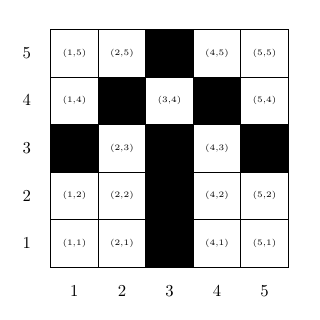Raster consisting of seven rows and seven columns. The rows are labeled 3,2,1,0,-1,-2,-3 from top to bottom. The columns are labeled -1,-2,-3,0,1,2 from left to right. The cells or pixels in the raster are black or white.
First row, labeled 3: white, white, white, white, black, white, white; Second row, labeled 2: white, white, black, black, black, white, white; Third row, labeled 1: white, black, white, black, white, black, white; Fourth row, labeled 0: white, black, black, white, black, black, white; Fifth row, labeled -1: white, white, black, black, black, white, white; Sixth row, labeled -2: white, black, black, white, black, black, white; Seventh row, labeled -3: white, white, white, white, white, white, white.
